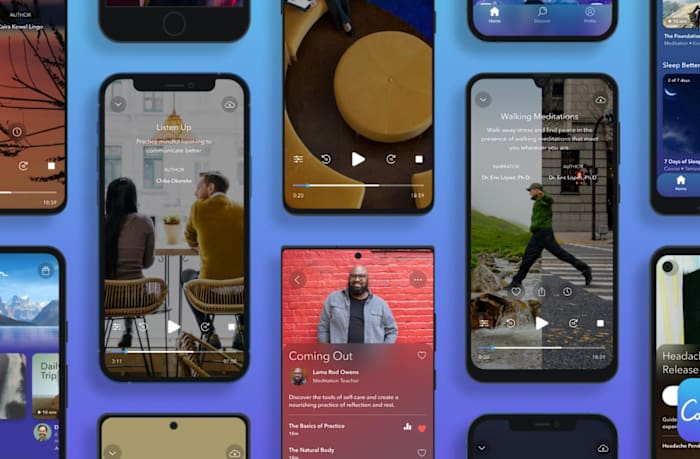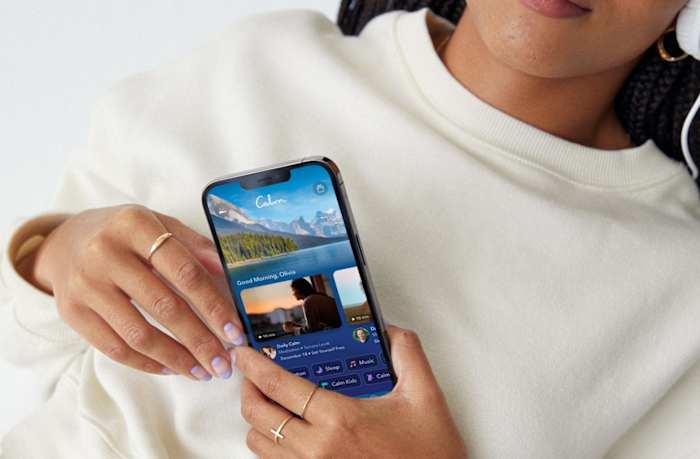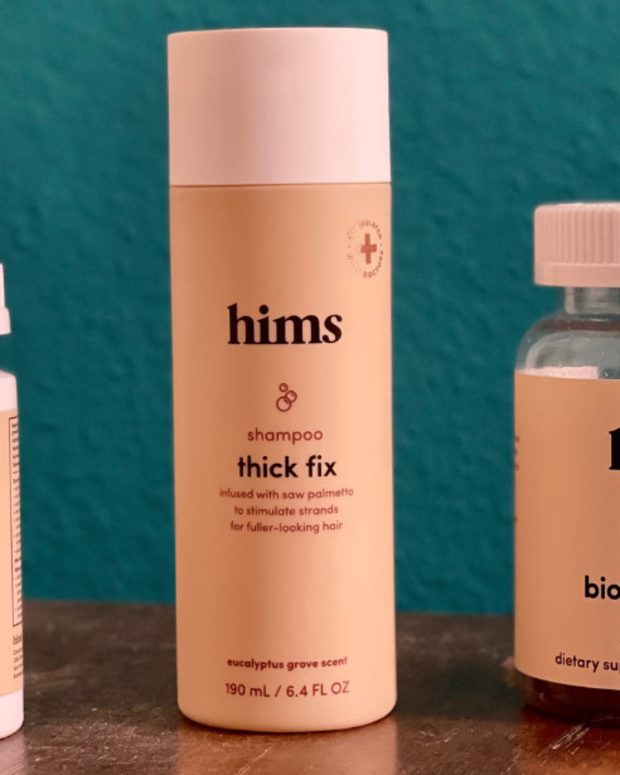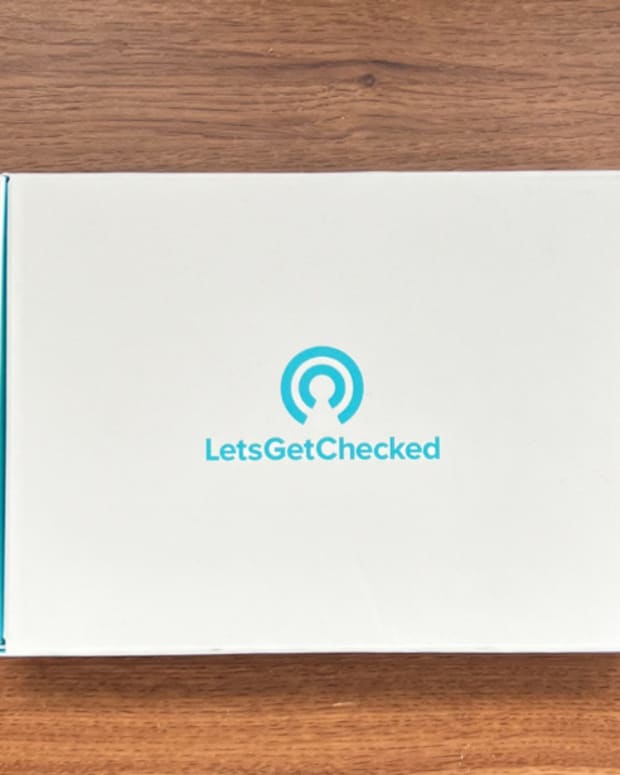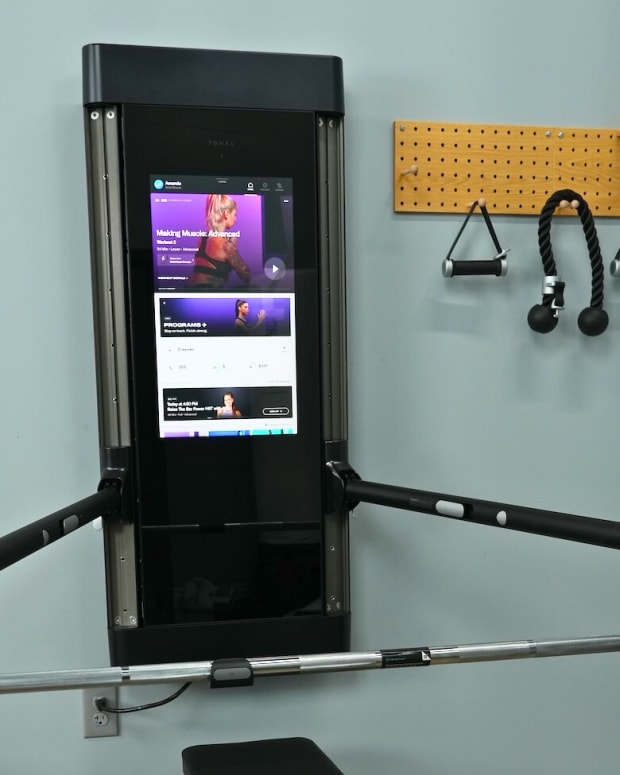The products featured in this article have been independently reviewed. When you buy something through the retail links on this page, we may earn commission at no cost to you, the reader. Sports Illustrated editorial staff are not involved in the creation of this content. Learn more here.
Key Features:
- Free seven-day Premium trial
- Three- to 30-minute meditations
- Beginner to advanced practice levels
- Content for children and families
Meditation can feel daunting, especially if you’ve never partaken in the now highly-popular ancient practice that’s been used for millennia to promote calm and reduce stress. Meditation practice has tripled in recent years from 4.1 percent to 14.2 percent of surveyed adults, and for good reason: studies show that daily mindfulness meditation can decrease negative mood and improve attention, as well as reduce symptoms of anxiety and depression.
So, what’s contributing to the recent rise of meditation? Health apps like Calm are offering smartphone users easy access to meditation programs and beyond, making integrating this practice into one’s daily life as simple as opening an app and spending a few minutes in it. With a reported more than four million paying subscribers and even more free users, Calm has just about everything a person needs for sleep, relaxation, stress relief and overall well-being.
From nature sounds to bedtime stories, Calm goes beyond a one-size-fits-all approach with a wide range of relaxation tools. Still, is Calm ultimately worth using—and can it actually benefit your mental health? In our Calm app review, we’ll share exactly how the app works, how it stacks up to competitors and whether or not mental health experts say it’s worth investing in.
This content is meant to be informative, but should not be taken as medical advice. It is not intended for use as diagnosis, prevention or treatment of health problems. Always speak with your doctor before starting any new supplement or exercise regimen.
Quick Spec Overview
- Subscription: Free version with limited content or premium version with three subscription tiers ($14.99 monthly, $69.99 annually or $399.99 for lifetime use). There is also a Calm family plan that provides up to six premium accounts for $99.99 annually.
- Available platforms: Apple and Android
- Programs available: Sleep stories, soundscapes, music, movement, breathwork, guided meditation, unguided meditation, masterclasses, check-ins and Calm Kids
- What Calm is best for: Meditation, sleep, relaxation and improving self-esteem
What Is the Calm App?
Calm is a meditation app that has been around for over 10 years. It has amassed more than 100 million downloads with an average rating of 4.8 out of 5 stars from 1.6 million reviewers. As the self-proclaimed “number one” app for sleep and relaxation, Calm was developed in 2012 by British entrepreneurs Alex Tew and Michael Acton Smith. It offers both a free version and a paid premium plan that unlocks full content access, as well as a family plan with up to six accounts.
Calm can be used for several health and wellness goals. Its main pillars include improving sleep quality, reducing stress or anxiety, improving focus and self-improvement. However, Calm isn’t just for adults. With its Calm Kids program, Calm can be used for virtually all age groups and has age-appropriate programming for children as young as three; this includes bedtime stories, lullabies and more, making Calm a wellness platform that entire families can benefit from.
Through a variety of evidence-based programming rooted in science, Calm uses technology—and the convenience of smartphones—to help improve users’ health and wellbeing. Whether you’re committed to calming anxiety or lulling yourself into a deep sleep, Calm has a diverse array of features that suit all needs and interests. While meditation courses may be Calm’s bread and butter (and claim to fame), Calm features include, but aren’t limited to: mindfulness practices, breathing exercises, soothing music and bedtime stories (yes, even for adults).
How Does the Calm App Work?
Calm programs aren’t simply focused on how to stay calm in the moment, or even how to fall asleep more soundly. They cover a variety of themes that range as far as dating, to quelling panic attacks, to even boosting your self-esteem. While you can certainly go into the app and explore different collections in Calm’s expansive library, Calm will initially ask you about your goals to create personalized content recommendations. At that point, you can choose goals like “increase happiness” or “develop gratitude,” which will populate the app with custom content.
However, don’t expect to go through the same old recycled content day after day. Calm regularly releases new content to keep its programming fresh and informative. You can also expect to encounter Calm celebrity partnerships, such as the Calm x Lebron James series that explores the importance of mental fitness (meaning your overall psychological, social and emotional health). There’s even a sleep story narrated by actor Matthew McConaughey. Tamara Levitt, who is Calm’s Head of Mindfulness, serves as a primary narrator of mindfulness programming as well.
You can download Calm for both iPhone and Android. It’s available in the Apple App Store or Google Play Store. Note, you won’t be charged automatically for a premium subscription (more on the differences between Calm’s free and paid versions below), instead Calm will only prompt you for credit card information if you sign up for a free seven-day trial, which will then renew as Calm Premium on a monthly or annual basis, depending on your subscription. There’s also a lifetime subscription available on the Calm website that will net you unlimited access for life.
Calm App Free vs. Calm Premium Versions
Depending on whether you have a free or premium subscription, you’ll be able to unlock certain features. A free version of Calm will naturally be very limited—you’ll be able to access a handful of timed meditations, the first day of multi-day meditation programs, one sleep story and mindful tools like check-ins that allow you to journal your feelings. One nice feature about Calm’s free version, however, is that you can access most of Calm’s famous Breathe Bubbles, which guide you through breathing exercises that promote relaxation, balance, restoration or focus.
If you plan on using Calm only occasionally, or for guided breathing (which we’ll explore the benefits of later), you may be able to get by with a free version of the app. However, a paid subscription will likely be worth it if you want to use Calm daily or if you’re looking for a wider variety of content (plus, it will eliminate pesky ads encouraging you to sign up for Calm Premium). You may be unsure if Calm is right for you, and if so, that’s O.K.—Calm offers a free seven-day trial period to first-time users so you can get a feel for premium content and whether it’s worth it.
With Calm Premium, you’ll unlock all of Calm’s features. This includes unlimited sleep stories; hundreds of guided meditations; exclusive music for focus, relaxation and sleep; calming nature sounds; masterclasses on peak performance; lullabies and sleep stories for kids; and weekly content. You’ll also be able to access the Daily Calm, or 10-minute daily meditation sessions.
Calm App Cost
If you look at the cost of a Calm annual subscription, you may initially balk at the price of $69.99 per year. However, if you break down the cost by month, it comes out to just $5.83 per month, or about the cost of one coffee drink at your local coffee shop. A yearly subscription will get you the best rate, since subscribing to Calm on a monthly basis will cost significantly more at $14.99 per month—nearly triple the price of an annual subscription broken down monthly. Those who are committed to Calm (and reaping the benefits) can also sign up for a lifetime subscription for $399.99, which is available on the Calm website only (you won’t find this option on the app).
Personally, I find the annual cost worth it, although it is one of the pricier apps that I subscribe to. While Calm certainly doesn’t replace in-person or online therapy for mental health concerns, I found it to be a great adjunct tool for stress and anxiety relief, meditation and guided breathing. Still, as mentioned earlier, if you plan on using Calm casually or for the Breathe Bubble, you may not find a premium plan worth it, and instead can use the free version.
Calm App Reviews
Calm has received an impressive 4.8 out of 5-star rating on the iOS store, which has collected 1.6 million reviews. Customers say that Calm’s relaxation music has helped them fall asleep in 10 minutes or less following tossing and turning, with many saying the sleep stories in particular are one of their favorite features on the app. Those who are fans of the sleep stories enjoy being able to listen to stories on headphones, which doesn’t disturb roommates or bed partners.
The Breathe Bubble is another fan-favorite among Calm users. Many customers claim daily use of this feature, and those who have used the app for many years say it has only gotten better with time. Still, like all app reviews, it can be hard to sift through which reviews are real, and which aren’t. That’s why we turned to Trustpilot for additional perspective and Calm reviews.
Out of 221 reviews on Trustpilot, Calm has received a 1.8 out of 5-star rating. The issue? Many customers complain of billing issues and surprise charges, especially with lifetime subscriptions that seemingly continued to charge year after year. Still, 221 reviews is virtually nothing compared to the more than one million reviews on the iOS store, which point to overall satisfaction and great experiences the overwhelming majority of Calm users have.
Our Experience With Calm
My Calm meditation app review comes from many years of using Calm, sometimes regularly, sometimes on-and-off as needed. I first signed up for Calm some eight years ago when a friend recommended using the Breathe Bubble feature, which offers guided breathing exercises, to reduce stress. Back then, I was using the bubble for the 4-7-8 breathing technique, a proven paced breathing strategy that can reduce anxiety and promote easier sleep. While I could follow the breathing counts on my own, having a visual guide was much more helpful and allowed me to better focus on my breathing.
By combining ancient deep breathing methods with visual stimulation,Calm’s Breathe Bubble can be an excellent tool for regulating breathing and decreasing anxiety, since anxiety can cause rapid breathing, says Michele White, Ph.D., LLP, LPC and owner of Michigan-based WBC Counseling. “Having an awareness of breathing is essential,” she says, noting that the Breathe Bubble can be incorporated into a mental health care regimen. “By focusing on breathing, it can serve as a distraction to the impetus of the anxiety and help to also decrease rapid heartbeats.”
Initially, I used Calm just for the Breathe Bubble. However, I quickly realized there was so much more that I could do with the app—and ultimately benefit from. I came into Calm with a more advanced understanding of meditation, since I often meditate on my own, but what I love about Calm is how beginner-friendly many of the meditation programs are. If you have no idea how to meditate, Calm will walk you through meditation in an easy step-by-step process. That being said, those who prefer a more advanced meditation can also use unguided meditation features such as timed meditation, which allows you to meditate on your own without a teacher or guide.
Be aware that every time you open the Calm app, you’ll hear relaxing sounds such as water flowing. While this never bothered me (since I often use Calm on my own), some Calm users complain about this feature and prefer that scrolling through the app be soundless. Still, I enjoy the calming noises, and I especially enjoy Calm’s music selection, which I often turn on when I’m practicing yoga (or meditation) on my own. I also like that you can select guided meditation sessions as short as three minutes or as long as 30 minutes, which fits in almost any schedule.
One popular Calm feature that I never took advantage of are the bedtime stories. Personally, I avoid phone use before bed since the blue light emitted by smartphones can disrupt sleep, so using Calm (or any app) while winding down to sleep goes against my personal sleep hygiene practices. On the flipside, I know many people who absolutely swear by Calm’s bedtime stories to help them sleep. Ultimately, phone use before bed is a personal preference, but it’s important to be aware of the potential drawbacks. (Some other options for promoting sleep are magnesium supplements or sleep aids.)
Calm’s Wisdom collection—which includes the series with Lebron James and other inspirational content—reminds me a bit of very relaxing podcasts. While these programs aren’t my favorite feature (I’m not a big fan of podcasts in general), they’re popular amongst users who use Calm for self-improvement or self-esteem. That being said, I’m a huge fan of Calm’s Movement series and stretches for waking up. Calm offers a wide range of gentle exercises that target lower body stress, powering up your core, stretching your back and even improving digestion.
I did find Calm’s journaling feature a little tedious, and never incorporated it much into my Calm app usage. However, if you’re pressed for time, but still want to record your daily mood, Calm allows you to record your mood with just one emoji, which can be helpful for busy individuals. If I’m not sure how I want to use Calm when I open the app, the Discover search feature helps me uncover new content that I may not initially gravitate towards on my own from the homepage.
What We Love about the Calm App
What stands out the most to me about Calm is how truly diverse its features are. For anyone committed to improving their mental health and boosting their overall wellness, Calm has just about everything you need to tackle your health goals. While features that align with mental and emotional wellness are arguably the shining star of Calm, Calm body exercises help people approach their wellbeing from a physical aspect as well - which I love about this app.
I also like that Calm branches out far beyond meditation and includes programs for inspiration, finding purpose at work and tackling common (and stress-promoting) issues like dating. While these features didn’t personally align with my health goals and reasons for using Calm, I love that they’re available as an option for those who turn to Calm to work on those specific areas. I also like that Calm has extensive programming for kids as young as three, and includes plenty of bedtime stories and lullabies that parents can feel confident in sharing with their children.
Calm won’t replace talk therapy or therapy-specific apps like Talkspace, but as one of the top mindfulness apps on the market, there’s a reason why so many people love using Calm as part of their mental health care regimen. What makes Calm so successful in my opinion is that it’s designed for people from all walks of life, with a diverse spectrum of goals, ages and interests. I love that I was able to find what I needed in Calm, but other Calm users could benefit from an entirely different set of features - making Calm much more than another cookie-cutter app.
What We Don’t Love About the Calm App
For all of its perks, Calm does come with a few drawbacks. Let’s start with the free version. If you’re not paying for the app, you’re going to have limited content and a lot of ads encouraging you to sign up for Calm Premium. This can easily get overwhelming (and annoying), even when jumping into a paid version of Calm can be an expensive investment.
There’s also a lot of content—often too much. If you don’t have your mind set on one specific program when you open the app (i.e. Breathe Bubble or a morning stretching exercise), you can expect to spend a lot of time scrolling to find content that sounds right for your mood. I liken this to scrolling through Netflix, where too much content can actually make you not want to use the app at all. I know this has happened to me several times when I didn’t have a clear agenda picked out.
The soothing rain background noise can also be a little frustrating. While you can technically turn this feature off, it’s not the easiest setting to figure out (and you may need to do a little Googling for detailed instructions). If you plan on using Calm daily, it also requires quite a bit of commitment. You certainly don’t have to spend hours on the app, but in order to build a solid routine (and get the most out of a Premium plan if you have one), you’ll want to make it a point to find time for Calm each day. Luckily, you can set reminders with Calm to nudge you if needed.
Who Is Calm Best For?
As with any app or program, there are people Calm is right and not right for. “Calm is a great fit for anyone who wants to practice relaxation techniques as part of their mental health care plan,” says licensed clinical social worker Steve Carleton, LCSW, CACIII, of Gallus Detox. Thanks to its numerous tools and resources, Calm can be an accessible—and easy—way to incorporate mindfulness into daily life, he explains. Plus, you can access the Breathe Bubble for free in moments of stress, which can be helpful for people prone to panic attacks or anxiety.
Who Calm Is Not Best For
One potential drawback to using the Calm app, Carleton explains, is that people might become overly-reliant on it to manage their stress, anxiety and other mental health concerns. “It’s important to remember that mental health care requires more than just relaxation strategies, it also involves proper diagnosis and treatment from a qualified professional.” Therefore, Carleton says that Calm may not be a good fit for people “looking for a quick fix to their mental health concerns.” While Calm can certainly be part of a mental health care plan, it shouldn’t be seen as a replacement for medical advice, he advises.
Calm vs. Headspace
Calm might be a leading meditation app on the market, but it’s not the only one in its ranks. Enter Headspace, a popular relaxation app that has similar building blocks as Calm: meditation, sleep, focus and movement. While Headspace may be more beginner-friendly, especially if you’re just learning meditation, Calm has stronger and more structured meditation programs overall. It also has a greater variety of programs, even though Headspace nudges out Calm in terms of looks with a much cleaner and more user-friendly interface. The cost is identical ($69.99 for an annual subscription) yet Calm takes the cake for better content and quality.
Calm vs. Talkspace
Another popular app to help improve your mental wellbeing is Talkspace. Talkspace differs from Calm in that its goal is to help make therapy more approachable and convenient, rather than focus on mindfulness alone. Through Talkspace you’re paired with a licensed therapist. These healthcare professionals have experience treating issues like depression, anxiety, stress, substance abuse, relationship issues, PTSD and eating disorders. While this app is much more costly than Calm (and prices vary depending on your plan), it is covered by many insurance plans.
Meditation Benefits
It’s no secret that meditation comes with a host of proven health benefits. Even brief meditation can decrease negative mood and enhance attention when practiced daily, and meditation in general can improve symptoms of anxiety, depression and pain. However, the benefits don’t end there: meditation can actually increase creativity, as well as reduce age-related brain changes.
So, how can Calm help bring out these positive benefits? “The benefit of the Calm app is that the app offers mindful guided meditation that can bring about a decreased anxious state,” White says, “which can allow a person to function more productively.” In our fast-paced world, White also adds that “having the Calm app easily available on a mobile device” can help prevent panic attacks, especially when used properly and early (i.e. doing a deep breathing exercise).
Psychotherapist and founder of socialworkup Therapy Jasmine Chandy, PLLC explains that using an app like Calm can also help people struggling with depression or anxiety to take a moment to focus on their wellbeing. “When an individual is feeling depressed, the activities that support mental health are typically the first ones to go,” she says. “Movement, mindfulness and the various activities that help us connect with ourselves and make us feel better start to feel out of reach.”
Calm, meanwhile, can put many of those activities a tap away. “The Calm app can reverse this trajectory by meeting the individual where they are and helping them experience doses of calm, clarity and hope,” Chandy adds. The Breathe Bubble and other guided breathing exercises in particular, she says, are an excellent way to “anchor people” during stressful moments. “During moments of anxiety, it can be difficult to calm ourselves on our own in the moment. Having the app to reach for can help decrease this mental load.”
Calm App FAQs
Here’s everything else there is to know about Calm.
Does Calm charge monthly?
Calm Premium (the app’s paid version) offers three subscription tiers: monthly, annual and lifetime. The annual subscription costs $69.99 and comes with a free seven-day trial. To opt for monthly billing, which costs $14.99, you’ll need to sign up for Calm through app stores. A lifetime subscription, on the other hand, costs $399.99 and is available through the website only.
What age group is the Calm App for?
Calm programs are designed for users as young as three years old (and include age-appropriate bedtime stories and lullabies), meaning Calm can be used for just about any age group.
Can I use Calm without paying?
While Calm Premium will unlock all of the app’s features, you can easily use Calm without paying. Calm offers several free tools (albeit a limited amount) that include timed guided breathing exercises, daily meditation programs, background scenes and a sleep story.
How long are meditations on the Calm app?
The Calm app offers a wide range of meditation sessions that range from as short as three minutes to as long as 30 minutes, depending on your needs. Daily Calm meditations, for example, are about 10 minutes a piece.
Does the Calm app track sleep?
Calm offers a variety of programs and tools that promote better sleep, but ultimately doesn’t track sleep. In order to track your sleep habits and cycles, you may want to invest in a fitness tracker equipped to track sleep (like an Apple Watch) or a sleep tracking app.
Final Thoughts: Is Calm Right for You?
Calm is an excellent smartphone app to have on hand to assist you with a variety of wellness goals, such as sleeping better, reducing anxiety or building self-esteem. From relaxing music and soundscapes to guided meditation, Calm offers a number of tools that benefit an array of interests and needs. Plus, it has content for almost all age groups. If you’re unsure whether Calm is right for you, be sure to read our Calm app review, or try Calm’s free seven-day trial.
Prices are accurate and items in stock as of publish time.

